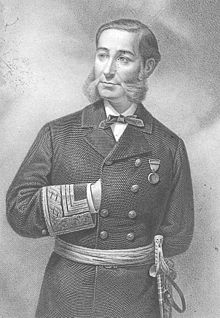Casto Méndez Núñez

Casto Secundino María Méndez Núñez (July 1, 1824 – August 21, 1869) was a Spanish Navy officer.
Biography
[edit]Méndez Núñez was from Vigo, Spain .[1] His father was a postal worker.[1]
In late 1865, during the Chincha Islands War between Spain, Peru and Chile, he became general commander of the Spanish fleet in the Pacific. He took that post after the suicide of Admiral José Manuel Pareja on November 26, 1865, two days after the naval Battle of Papudo. [2]: 17 As general commander, he received a promotion from Commodore to Rear Admiral.
In February 1866, Méndez Núñez sent two of his most powerful ships, the screw frigates Villa de Madrid and Reina Blanca, south to destroy the combined Chilean-Peruvian fleet. The resulting Battle of Abtao ended indecisively. After the Chilean government ordered all vessels communicating with the Spanish fleet to be barred from Chilean ports, Mendez Núñez presented an ultimatum from the Spanish government, on March 24: if Chile did not meet Spanish demands, he would bombard Valparaíso, an undefended town and the port.[3]
Chile not having met the Spanish demands, on March 31 the Spanish fleet shelled and burned Valparaíso, on destroying Chile's merchant fleet.[4]
When Hugh Judson Kilpatrick, the American Minister to Chile, learned that Méndez Núñez had been ordered to bombard the port of Valparaíso, he asked the American naval commander Commodore John Rodgers to attack the Spanish fleet. Méndez Núñez famously responded with "I will be forced to sink [the US ships], because even if I have one ship left I will proceed with the bombardment. Spain, the Queen and I prefer honor without ships than ships without honor (España prefiere honra sin barcos a barcos sin honra.)"
On May 2, Méndez Núñez's fleet fought at the Battle of Callao, during which he was injured nine times. This was the final battle in the war between Spanish and Peruvian forces. On May 9, Méndez Núñez and his fleet departed for Spain.[3]
Honors
[edit]Four Spanish Navy warships have been named Méndez Núñez:
- An armoured frigate, converted from the screw frigate Resolución, renamed in 1870, and retired in 1888.
- A Blas de Lezo-class cruiser built in 1924 and retired in 1963.
- The former USS O'Hare (DD-889), a Gearing-class destroyer, in service in the Spanish Navy from 1973 to 1992.
- Méndez Núñez, an Álvaro de Bazán''-class frigate commissioned in 2006.
The municipality of Mendez, Cavite, Philippines, was named in honor of Méndez Núñez.
A room at the Pazo de García Flórez in Pontevedra, Spain, is dedicated to a display of Méndez Núñez's office.[5]
References
[edit]- ^ a b González, Agustín Ramón Rodríguez (2024), Harding, Richard; Guimerá, Agustín (eds.), "Casto Méndez Núñez: The Admiral who could have been Regent, 1861–1868", Sailors, Statesmen and the Implementation of Naval Strategy, Boydell and Brewer, pp. 104–119, doi:10.1017/9781805431343.007, ISBN 978-1-80543-134-3
- ^ Farcau, Bruce W. (2000). The Ten Cents War: Chile, Peru, and Bolivia in the War of the Pacific, 1879 - 1884 (1. publ ed.). Westport, Conn. London: Praeger. ISBN 978-0-275-96925-7.
- ^ a b Scheina, Robert (2003). Latin America's Wars: The Age of the Caudillo, 1791-1899. Brassey's. ISBN 9781597974776.
- ^ "Bombardment of Valparaiso.; Official Report by Admiral Casto [sic] Memdez [sic] Nunez. Curous [sic] Statement Regarding the Course of Gen. Kilpatrick and Commdore [sic] Rogers". New York Times. May 10, 1866. p. 2. Retrieved February 7, 2024.
- ^ "Pazo García Flórez, edificio Castro Monteagudo: hoy un bello museo. Memorando Civitatem Duo Pontes". Pontevedra Viva (in Spanish). 26 February 2022.
